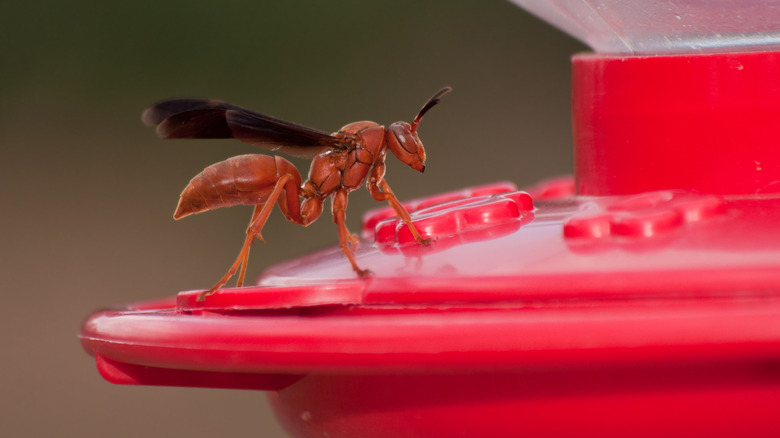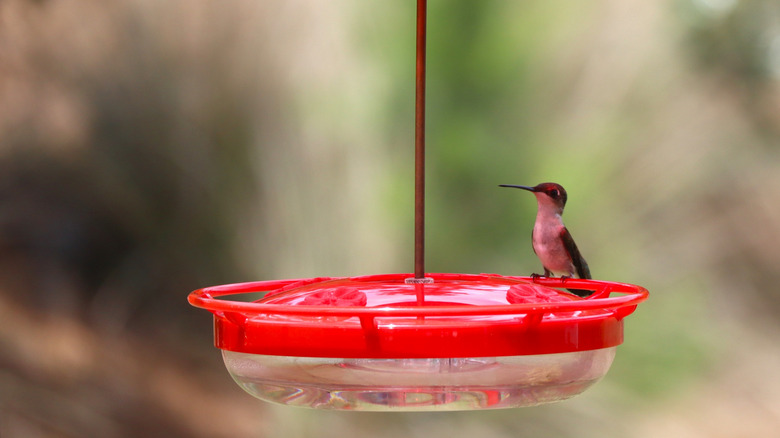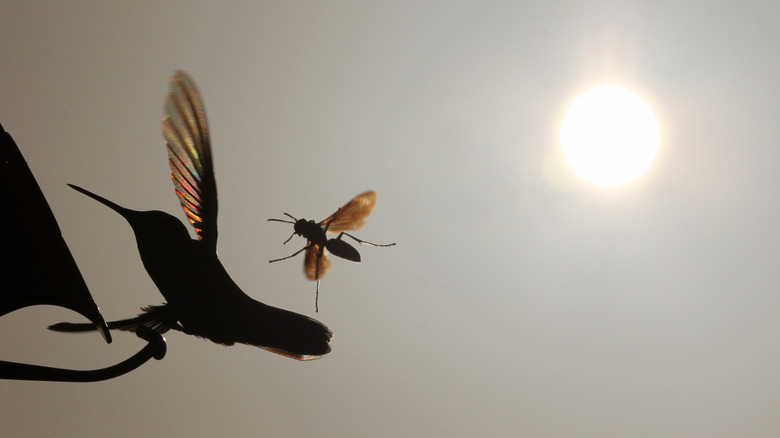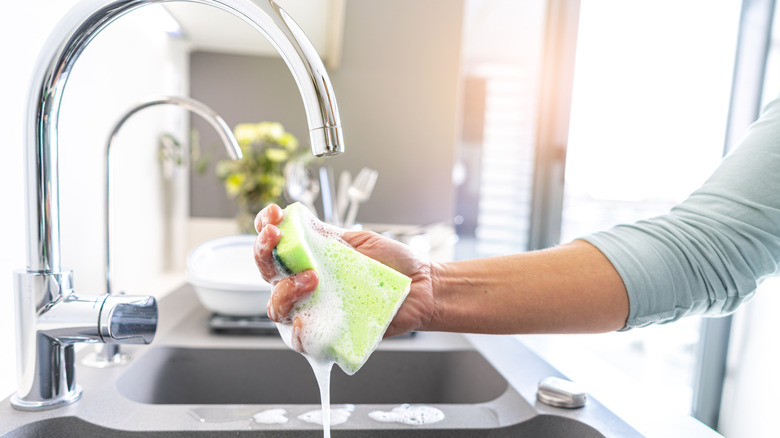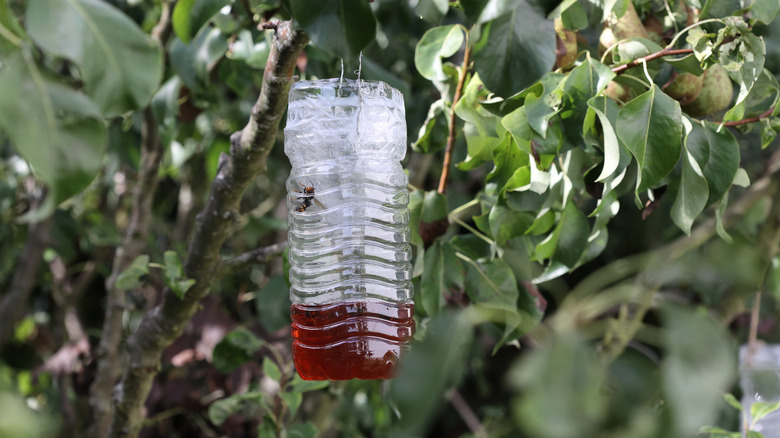5 Tips For Guarding Your Hummingbird Feeder From Wasps
We may receive a commission on purchases made from links.
Adult wasps love the nectar in hummingbird feeders because they need a high-carb diet filled with lots of sugar. Still, the last thing anyone wants to see is a hummingbird fighting yellowjackets at their feeder. Fear not, there are a whole range of strategies you can deploy to keep the stinging pests away, ranging from buying the right kind of feeder to making sure you keep it clean.
Keeping wasps away from feeders is important because they can be harmful to hummingbirds. Wasps can chase a small bird away, or they can sting and kill the small birds with their venom. Even worse, wasps sometimes target hummingbird nests and kill hatchlings. Hummingbirds seem to have an innate distrust of wasps. They will even avoid parts of the yard where there are large numbers of the stinging insects, including at the feeder.
You might be tempted to use insecticides to kill the wasps, but the chemicals in them can harm hummingbirds, too. Researchers at the University of Toronto found that neonicotinoids, the chemicals found in a lot of insecticides, affect hummingbirds' metabolic rates, causing them to be sluggish. They need a lot of energy to find food, so a weak and tired hummingbird could be a recipe for disaster. Some kinds of insecticide, even in small doses, can even affect a hummingbird's ability to fly or stand. But there are ways to keep wasps away from your hummingbird feeders without using chemicals. Here are five easy tips.
Use a saucer instead of a bottle feeder
One way to keep wasps away from your feeder is to choose one that makes it harder for them to reach the nectar. Many common hummingbird feeders are shaped like tubes or hanging bottles, where gravity feeds it into a dish at the bottom, and a vacuum-like seal keeps it from dripping out. But the filled-to-the-brim vacuum feeders means that wasps easily can reach the nectar, too.
Saucer feeders, on the other hand, like the Feed Garden saucer feeders, make it harder. They have the nectar sitting at the bottom of a tray requiring hummingbirds to use their long beaks and tongues to access the nectar. Wasps and bees feed with a proboscis, a kind of trunk or snout. It's much shorter than a hummingbird's beak, so the further away the sugar water is, the harder it'll be for wasps to reach the nectar.
The kind of feeder you get isn't the only consideration. You should also avoid any yellow accents. Yellow is a wasp's favorite color. Though some wasps also like white, turquoise, or pink, yellow is the favorite among most species of wasps. They're naturally attracted to many yellow flowers, like yarrow or golden rod. Some wasps eat honey as well, so yellow is a signal to them that it's lunch time. You're better off sticking to just red accents for your hummingbird feeder. Hummingbirds love red, which works out nicely, since wasps can't really see red.
Buy or make your own wasp guard for your hummingbird feeder
No matter what color your feeder might be, it feels like if tree wasps find that the feeding holes are big enough to climb through, then they'll come in swarms. Some hummingbird feeders come with built-in bee and wasp guards, basically a kind of tube or plastic cage that protects the nectar. You can look for these when you're shopping for a hummingbird feeder, or you might be able to retro-fit an old feeder with a special attachment to keep wasps away.
There are a couple of different wasp guards to attach to your feeder. One is a plastic tube that elongates the feeder hole, making it too long for a wasp but just right for the long beak of a hummingbird. Another is a plastic cage that fits over the hole. You could also make your own wasp guard with some plastic mesh. All you'll need for your own DIY wasp guard are glue, scissors, and an old onion or potato plastic mesh bag.
It's a simple process to make one. Just cut up small squares of the mesh. Apply some glue around each hole on the underside of the feeder cover. Then, fix your mesh across the holes. Hummingbirds need only a hole as small as 1/8th of an inch wide to feed. Anything you can do to distance the wasp from the nectar is ideal.
Avoid putting your hummingbird feeder in these spots
Now that you've got the right feeder with the proper wasp guards, where to put it? It turns out, where you place the feeder in the yard does matter. Avoid sunny spots. Wasps love sun since it helps them regulate their body temperature. The sun also heats up the nectar, and makes it ferment faster, which will attract more wasps and bees. Shady spots will help keep the nectar cooler and fresher for longer, and as a bonus, hummingbirds typically need to fly shorter distances to shady feeders perched near trees or shelters, which saves them energy and effort.
Also, wasps prefer some kinds of plants, flowers, or shrubs, so learn what plants attract wasps – like sweet fennel or Queen Anne's lace — and avoid putting your feeders near them. Also avoid hanging a hummingbird feeder anywhere near trash, compost, or other garbage wasps love. It's also a good idea to make sure the lids on any nearby trash cans are secure.
Double check, too, that you're not hanging your feeder anywhere near a wasp nest. Wasps can make paper nests in almost any nook or cranny, and yellow jackets often nest in the ground. You might also want to move your feeder fairly frequently if wasps keep finding it, so picking a new spot in your garden for the feeder can help. If you move it a few feet you can trick the wasps, but not really fool the hummingbirds.
Keep your hummingbird feeder clean
If you're still struggling with wasp control in your yard and the wasps keep finding your feeder, there might be a leak that's attracting their attention. Make sure your feeder isn't leaking and wipe off any sticky spots on the outside. It's a good idea to keep your feeder clean and leak free to get rid of sticky residue that wasps love.
To properly clean your feeder, it's probably best to use a hydrogen peroxide or a vinegar solution to clean your feeder. Avoid dish soap, since it can leave a harmful residue behind. Use a small brush to really clean sticky bits from the feeder holes. Keeping the hummingbird feeder clean is also healthier for your hummingbirds. It's a good idea to change the sugar water and wash it every day or two, especially in hot weather to avoid mold or bacteria growth that can make hummingbirds sick. Also, if the nectar in your feeder grows old, it'll get thicker and stickier, which is harder for the birds to eat. It will also attract more bees and wasps because they like the sour-sweet smell.
You'll know it's time to wash your feeder if the nectar gets thick or cloudy. Or you may start to see mold spots start to growing on the glass. Also, if there have been a lot of wasps or ants feeding at the feeder, it's a good idea to clean it anyway because they can contaminate the nectar with dirt or bacteria.
Make your own wasp trap
If you've tried cleaning your feeder and still have wasps, you may need to use other means to keep them away from your hummingbirds. You can buy wasp traps, like these HECO ARMOR sticky traps for $20. Or, you can make your own. All you'll need is an empty soda bottle, some sugar water, and some tape. Start by cutting the plastic bottle in half. Add in sugar water or fruit to the bottom to lure the wasps in. Then, invert the bottle into itself, so the neck of the bottle faces downward. Tape the two pieces together with a swipe of tape around the top, and then place outside. Wasps will fly in, and then get trapped when they can't find the narrow exit.
While traps feel like a great solution, the downside is that they might wind up attracting more wasps or insects to your yard. Also, some studies have shown that traps don't really affect wasp populations that much. And even worse, they might increase the chance of one stinging a visitor in your backyard.
Plus, wasps can be helpful in the garden. They do a great job pollinating many vegetable plants and flowers. Some plants have even evolved to attract them because they're such good pollinators. Wasps kill beetles, weevils, and other pests chomping on your flowers. They typically feed them to growing larvae at their nests. So, if you and the hummingbirds can find a way to live with wasps, your flowers will likely benefit.
